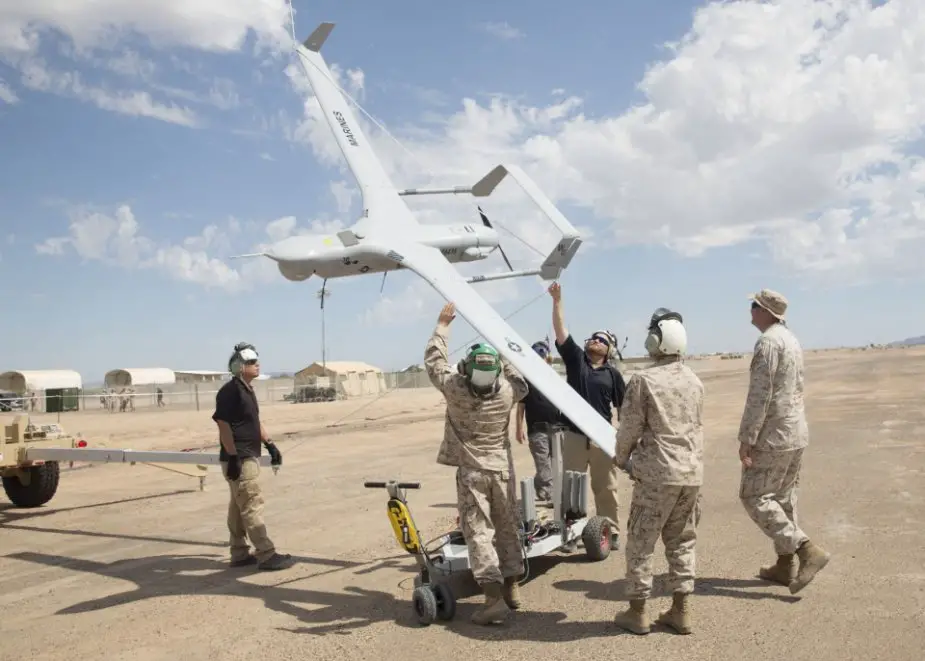Breaking news
U.S. Marines deploy RQ-21 Blackjack drones in Australia for the first time.
Officials from both U.S. and Australia have confirmed that the annual U.S. Marine Corps rotation will see RQ-21 Blackjack drones deployed in Australia for the first time, Sandy Milne reports in Defence Connect. Though delayed by two months due to pandemic restrictions, some 1,200 Marines have departed for Darwin.
Follow Army Recognition on Google News at this link

U.S. Marines with Marine Unmanned Aerial Vehicle Squadron (VMU) 1 recover their new RQ-21A Blackjack Unmanned Aerial System after its flight aboard Cannon Air Defense Complex in Yuma, Ariz., Aug. 16, 2016 (Picture source: U.S. Marine Corps/Sgt. Brytani Wheeler)
RQ-21 Blackjack drones will soon arrive in Australia to support Marine Rotational Force. These drones will be used to monitor remote battlespace. The troops will practice deploying the drones and using them to relay information back to unit command. The rotation troops consist of U.S. Marines from Twentynine Palms, California, Combat Logistics Battalion 5 from Camp Pendleton, California, and a command element from the III Marine Expeditionary Force from Okinawa.
While these RQ-21 Blackjack drones don’t belong to the Australian army, it is currently working on getting its hands on its own MQ-4C Triton drones and MQ-9 Reaper drones. Australia said in 2018 that it will be purchasing six MQ-4C Triton drones with three of those currently being in its hands.
The Boeing Insitu RQ-21 Blackjack, formerly called the Integrator, is an unmanned air vehicle designed and built by Boeing Insitu to meet a U.S. Navy requirement for a small tactical unmanned air system (STUAS). It is a twin-boom, single-engine monoplane, designed as a supplement to the Boeing Scan Eagle. The Integrator weighs 61 kg (134 lb) and uses the same launcher and recovery system as the Scan Eagle.
The RQ-21A Blackjack is designed to support the U.S. Marine Corps by providing forward reconnaissance. A Blackjack system is composed of five air vehicles and two ground control systems. The air vehicles can be launched on land or on a ship by a rail and land using a "skyhook" recovery system, where a vertical wire must be hooked onto its wing; when on the ground, the launch and recovery systems are towable by vehicles. Its wingspan is 16 ft (4.90 m) and it can carry a 39 lb (18 kg) payload. The day/night camera can achieve a resolution rating of 7 on the NIIRS scale at 8,000 ft (2,400 m).
The Marines are working with Insitu to modify the Blackjack fuselage to carry greater and more various payloads. Enlarging the fuselage would increase its maximum takeoff weight from 135 lb (61 kg) to 145 lb (66 kg) and lengthen endurance from 16 hours to 24 hours. New turrets are being explored as well as other payloads including a synthetic-aperture radar to track ground targets, a laser designator to mark targets for precision-guided munitions, and foliage-penetration capabilities for foreign customers operating in lush environments. The Office of Naval Research (ONR) plans to add a sensor to the Blackjack that combines an electro-optical camera, wide-area imager, short wave infrared hyperspectral imager, and a high-resolution camera for use as an inspection sensor into a single payload by 2020.
In Marines service, the Blackjack sometimes uses the designation MQ-21,[18] where the 'M' prefix indicates "ground-launched, mobile" operations, versus the 'R' prefix indicating operating from a surface ship.


























